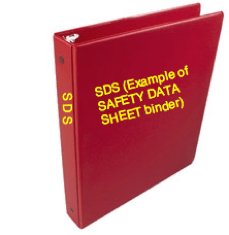DO NOT COPY - ALL contents - Copyright Protected
DRAM Ventures Inc. / www.firesafetraining.com
Table of Contents
1. 2015 WHMIS / GHS Overview
2. 2015 WHMIS Classification
3. 2015 WHMIS Labels
4. 2015 WHMIS / GHS SDS (Safety Data Sheet)
5. 2015 WHMIS / GHS Summary & Quiz
2015 W.H.M.I.S. / GHS SDS
(Safety Data Sheet)
DO NOT COPY - ALL contents - Copyright Protected
DRAM Ventures Inc. / www.firesafetraining.com
A technical document providing information on a controlled product, for example:
- hazardous ingredients
- hazards (fire, explosion, reactivity)
- health effects of exposure (acute and chronic)
- hazard evaluation related to storage and handling
- measures to protect workers
- emergency procedures
SAFETY DATA SHEETS (SDS) are commonly kept in a standard 3-ring type of binder which is labelled, "SAFETY DATA SHEETS". EVERY CONTROLLED PRODUCT USED AT A SPECIFIC WORKSITE MUST HAVE THE CORRESPONDING SDS INFORMATION AVAILABLE
This would also include field worksites where the SDS information may be in a pickup truck that is NOT LOCKED.
SDS INFORMATION may be in any language and ALL workers must be able to understand them.
SDS INFORMATION may be on a computer as long as ALL workers know how to access this information on the computer.
The downside to a computerized SDS system is that an emergency incident may cause a power outage at the critical time when the SDS information is needed.
There should be a designated company employee assigned to maintaining the complete WHMIS program at the workplace.
DO NOT COPY - ALL contents - Copyright Protected
DRAM Ventures Inc. / www.firesafetraining.com
Links to a few SDS Information packages
These are just a few examples / We suggest you look at a couple, there may be a quiz.
Railway Fusee / Road Flare / Burning Off Flare
Understand there are thousands of controlled products that require and have SDS's. (Check the date on any SDS)
One of the quickest ways to find an appropriate SDS is via the internet.
The SDS's that we link to above, may no longer be valid however they do have the major sections shown. We show them as examples.
NoteWHMIS 2015 / GHS - SDS is only valid UNTIL SUCH A TIME AS THERE IS A SIGNIFICANT CHANGE TO THE PRODUCT AND THE SUPPLIER UPDATES THEIR SDS |
 |
| SECTION | IDENTIFICATION | OTHER INFORMATION |
|---|---|---|
| SECTION 1 | IDENTIFICATION (Name of Product) | - Other means of identification - recommended use & restrictions on use - Canadian Supplier name and contact - Emergency contact phone and restrictions on this number (i.e. only available Mon-Fri) |
| SECTION 2 | HAZARDS IDENTIFICATION | - Hazard Classification (class, category) of product - Label Elements (Pictogram or name of pictogram; Signal Word; Hazard Statements; Precautionary statements - Other Hazards that may not be in classification (i.e. molten material - FUSSES) |
| SECTION 3 | INFORMATION ABOUT INGREDIENTS (COMPOSITION) | When a hazardous ("controlled") product is a material or substance - Chemical name - Common name(s) - Chemical Abstract Service (CAS) registry number and identifiers - Chemical name of impurities, stabilizing solvents and/or additives++ For each substance in a mixture that is in the Health Hazard Class +++ NOTE: Confidential business information rules may apply. This means that ALL ingredients may not be listed. However, those that may cause harm should be) |
| SECTION 4 | FIRST AID TREATMENT | - Describes what First-Aid actions must be carried out; depending upon exposure (i.e. inhalation, skin contact, eye contact, ingestion) - Critical symptoms and effects (immediate and longer term (delayed) |
| SECTION 5 | FIREFIGHTING MEASURES | - proper extinguishing media - improper extinguishing media - Specific hazards as a result of the product being involved in fire - |
| SECTION 6 | ACCIDENTAL RELEASE - WHAT TO DO | - personal precautions - procedures and materials for containment and clean-up |
| SECTION 7 | HANDLING AND STORAGE | - safe handling procedures - proper storage (also what NOT to store with or near this product) |
| SECTION 8 | EXPOSURE CONTROLS / PPE (Personal Protective Equipment) | - control, (occupational exposure guidelines or biological exposure limits) - engineering controls - Individual protection (PPE - -hygiene considerations (ie. eye/face, skin, lungs) |
| SECTION 9 | PHYSICAL & CHEMICAL PROPERTIES | - physical appearance - smell - odour threshold - pH - melting or freezing point - boiling point and range - flash point - evaporation rate - flammability (solid or gas) ; upper / lower flammable / explosive limit |
| SECTION 10 | STABILITY & REACTIVITY | - reactivity - chemical stability - risk of hazardous reactions - conditions to avoid - incompatible materials (i.e. putting acetone into a styrofoam cup - it will dissolve cup) - hazardous decomposition products (by-product) |
| SECTION 11 | TOXICOLOGICAL INFORMATION | Degree of impact on aquatic life, soil, air (toxicity, persistence) |
| SECTION 12++++ | ECOLOGICAL INFORMATION | - Not required by 2015 WHMIS - Not adopted from GHS - Not required by Canadian OSHA |
| SECTION 13++++ | DISPOSAL CONSIDERATIONS (Methods) | ++++ (12, 13, 14, 15) These sections must have the headings listed however Canadian regulations give the supplier the option to NOT provide information. |
| SECTION 14++++ | TRANSPORT INFORMATION | |
| SECTION 15++++ | REGULATORY INFORMATION (The Law!) | |
| SECTION 16 | OTHER INFORMATION |
DO NOT COPY - ALL contents - Copyright Protected
DRAM Ventures Inc. / www.firesafetraining.com
We wish to acknowledge and thank all organizations and persons for the use of all videos and photos on this web site.
